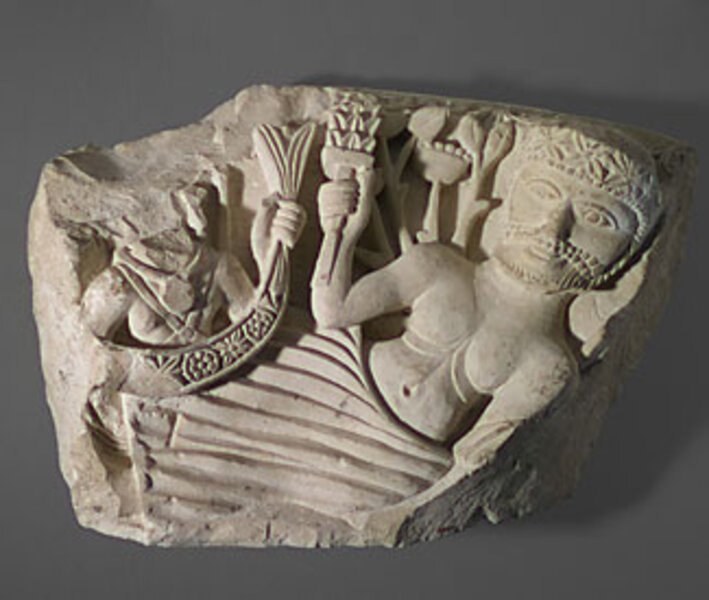Faking it, artfully
| New York
The Brooklyn Museum of Art surprised some New Yorkers last month when it confirmed that it would show a handful of expert forgeries alongside a February exhibition on late antique art. The exhibition, tentatively titled "Unearthing the Truth: Egypt's Pagan and Coptic Sculpture," will focus on a collection of stone artwork dating from the 5th to the 7th century C.E.
According to Edna Russman, curator of Egyptian, classical, and ancient Middle Eastern art at the Brooklyn Museum, experts have long harbored reservations about the 31-piece collection. After a three-year inquiry conclusively revealed that some of the sculptures were fakes – and most had been significantly retouched – Dr. Russman began planning a large exhibition at the museum's recently renovated Brooklyn campus.
"The sculptures had been in storage for decades, but they were very popular when they were first exhibited. I was impelled to put together another exhibition," Russman said in an interview. "And if I'm going to put them out there again, I have to put out the fakes too. This story has to be told if we're going to show this material at all."
Russman's decision, first reported in the London-based Art Newspaper and carried breathlessly by a wide range of media outlets here, calls into question the authenticity of similar artwork in institutions across the world. As the Art Newspaper noted, "[M]useums which acquired Coptic sculptures in the past 50 years are likely to face similar problems."
But more intriguingly, say many experts, the firestorm has helped expose an important evolution in the relationship between museum and patron. "In the past, no one wanted to admit their mistakes. It was part of the anonymous museum – that stone wall," says Graham Beal, director of the Detroit Institute of Art (DIA). "Now there's a real sense that the museum needs to be humanized and given a level of transparency. It represents a shift in attitude. It used to be that when things were faulty, they were wished away, never to be seen again."
The DIA, which itself recently emerged from an extensive architectural face-lift, has talked about doing an exhibition on forgeries. "I know from experience, from being on symposiums from South Bend to the Vatican," says Dr. Beal, "that there's a lot of interest [among] sitting directors in being more open, in investing the general public with trust. These works of art are being shown to the public. We need to be honest about what they are."
Kevin Stayton, chief curator and vice director for curatorial affairs at the Brooklyn Museum, argues that displaying the fakes alongside the authentic pieces will help strengthen patrons' trust. Museums, he says, "have traditionally put themselves forward as an anonymous voice of authority. That idea's been challenged more and more in the past few decades. Museums should become a place for the exchange of ideas, for discussions, for the airing of opinions." Being honest about mistakes is only natural, he says. "Pretending you know everything and never made a mistake? No one buys that anyway."
The Brooklyn Museum, of course, is not the first institution to prominently display a collection of known fakes. In 1990, the British Museum – that most august of institutions – launched an exhibition called "Fake? The Art of Deception." In 1996, the Nelson-Atkins Museum in Kansas City, Missouri, hosted "Discovery and Deceit: Archaeology and the Forger's Craft." In 2006, England's Victoria and Albert Museum trotted out a host of fake Picassos and Chagalls, as part of an effort by Scotland Yard to crack down on expert forgeries.
And then there are the institutions that unknowingly – and prominently – deal in fakes. Last year, for instance, the Hamburg Museum of Ethnology in Germany had to offer refunds to about 10,000 visitors after the Chinese government alleged that a popular exhibition on Terracotta Warriors was a total fraud.
"Before our exhibition opened, a few patrons in Kansas expressed concern that the Nelson-Atkins was going to lose credibility," says Robert Cohon, who organized the 1996 exhibit. "And I said, 'It's OK. We're honest, we're scrupulous, we're big enough to admit that it's part of being human.' It wasn't so much a matter of poking fingers at people."
Dr. Cohon, a research scientist at the University of Missouri and curator of ancient art at Nelson-Atkins, regularly writes and lectures on forgeries. "It's a ton load of fun," he laughs. "As academics, we spend time dealing with, 'Is this a young Tiberius? a middle-age Tiberius?' things like that, and then you become a detective – it can lift you up and out of the grind."
This, he says, is what institutes have to gain from organizing an exhibition that includes fakes. "For us, it worked very, very, very well. The museum-goers became involved in that hunt. They were fully engaged, not passively engaged."
At the Brooklyn Museum, Russman says she hopes to separate the forgeries from the ancient sculptures, but to use the gallery space to draw visual and physical connections between the two. "Some of the forgeries," she says, "are actually very inventive and should stand by themselves. I must say that in the most ambitious of those forgeries, the sculptors may have been trying to outdo the ancient pieces."
In an interview, Gary Vikan, the scholar who identified some of the Brooklyn Museum's fakes in 1977, said the idea of displaying a particularly beautiful fake has its own twisted appeal. "People will say, 'If something's perfect, physically perfect, what's wrong with fake? What's wrong with fake if it looks right?' " says Dr. Vikan, who is now the director of the Walters Art Museum in Baltimore. "And then you might think, 'Well, museums may deal in beauty, but scholars deal in truth.' "
"The art world is often thought of as having this back-drop of pointy-headed intellectuals," he says. "And all of a sudden, when they make a mistake, and you're invited to see it, it can be a lot of fun."







